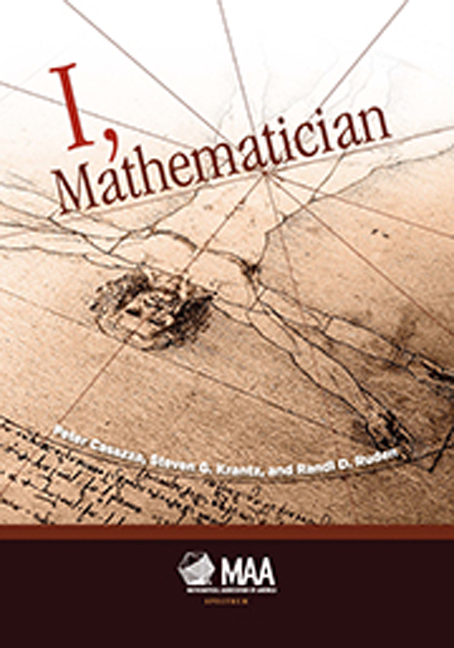Book contents
- Frontmatter
- Contents
- Preface
- Part 1 Who Are Mathematicians?
- Part II On Becoming a Mathematician
- Part III Why I Became a Mathematician
- Foreword to Why I Became a Mathematician
- 20 Why I Became a Mathematician: A Personal Account
- 21 Why I Became a Mathematician?
- 22 Why I am a Mathematician
- 23 Why I am a Mathematician
- 24 Why I am a mathematician
21 - Why I Became a Mathematician?
from Part III - Why I Became a Mathematician
- Frontmatter
- Contents
- Preface
- Part 1 Who Are Mathematicians?
- Part II On Becoming a Mathematician
- Part III Why I Became a Mathematician
- Foreword to Why I Became a Mathematician
- 20 Why I Became a Mathematician: A Personal Account
- 21 Why I Became a Mathematician?
- 22 Why I am a Mathematician
- 23 Why I am a Mathematician
- 24 Why I am a mathematician
Summary
Becoming a mathematician requiresmany ingredients. One of them is to enter the academic world (at least in France).This was the most natural thing for me to do,which is demonstrated by the fact that my two brothers also are academics. Indeed, two of my great-grandfathers were teachers during the second half of the nineteenth century. My grandmother (on my father's side), then both my parents, were teachers in high school. It would have taken a lot of energy to do something different (I wanted to be an engineer at one time), at least for me: my mother dreamed of having her elder son becoming a diplomat, but she had no such dream for me, except that I be successful in my studies.My parents were lucky on this point: my brothers entered the prestigious Ecole Normale Supérieure and in 1963, I entered its variant for girls at the time (the so called Ecole de Sèvres), where my grandmother had studied mathematics seventy years before me.
Choosing a topic was not such a natural familial choice:my grandmother and my mother taught mathematics, but my father taught humanities. My eldest brother, Georges Nivat, chose to study Russian and became a well-known slavist, while the second one, Maurice, started studying mathematics, then became a well-known computer scientist. Even if he was seven years older than I, Maurice and I spent a lot of time together before he left home as a student. But, apart from special occasions we did not speak of mathematics: he was the leader and we cycled, climbed trees, he took me for rides in the forest, we played cards, collected stamps, and shared the same passion for medieval art (it was in the fifties, we had of course no TV and only a few toys, even if we were lucky children). He taught me a lot of things, among which history was probably the most prominent. One year we decided to speak with a secret alphabet. Just A = 1, B = 2, etc. We spoke rapidly this way during one week, after which the cousin who was with us started to understand a little of what we were saying. We then decided to take the alphabet in reverse.
Maurice and my mother got interested in my training in mathematics when I was 10. At that time one had to pass a first exam to enter secondary school.
- Type
- Chapter
- Information
- I, Mathematician , pp. 257 - 259Publisher: Mathematical Association of AmericaPrint publication year: 2015

